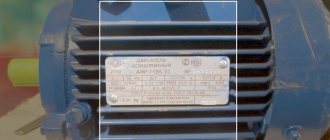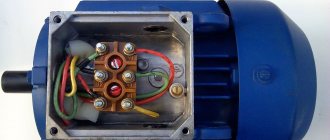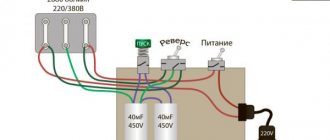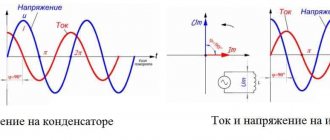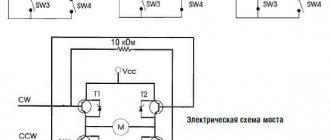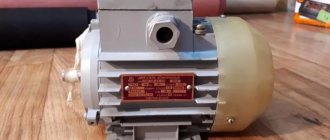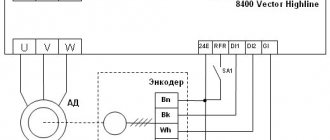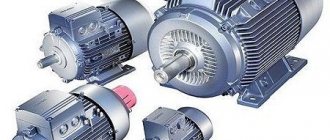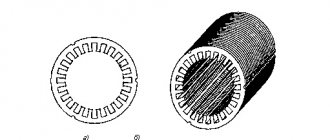Electric motors appeared quite a long time ago, but great interest in them arose when they began to represent an alternative to internal combustion engines. Of particular interest is the issue of electric motor efficiency, which is one of its main characteristics.
Each system has a certain efficiency factor, which characterizes the efficiency of its operation as a whole. That is, it determines how well a system or device delivers or converts energy. Efficiency has no value, and most often it is presented as a percentage or a number from zero to one.
Efficiency parameters in electric motors
The main task of an electric motor is to convert electrical energy into mechanical energy. Efficiency determines the effectiveness of a given function. The formula for electric motor efficiency is as follows:
- n = p2/p1
In this formula, p1 is the supplied electrical power, p2 is the useful mechanical power that is generated directly by the engine. Electrical power is determined by the formula: p1=UI (voltage multiplied by current), and the value of mechanical power by the formula P=A/t (ratio of work per unit time). This is how the calculation of the efficiency of an electric motor looks like. However, this is the simplest part of it. Depending on the purpose of the engine and the scope of its application, the calculation will differ and take into account many other parameters. In fact, the formula for electric motor efficiency includes many more variables. The simplest example was given above.
Which engine has the highest efficiency?
Now I want to talk about gasoline and diesel options, and find out which of them is the most efficient.
To put it in simple language and without getting into the weeds of technical terms, if you compare the two efficiencies of gasoline and diesel units, the more efficient of them is, of course, diesel and here’s why:
1) A gasoline engine converts only 25% of energy into mechanical energy, but a diesel engine converts about 40%.
2) If you equip a diesel type with turbocharging, you can achieve an efficiency of 50-53%, and this is very significant.
So why is it so effective? It's simple - despite the similar type of work (both are internal combustion units), diesel does its job much more efficiently. It has greater compression, and the fuel ignites using a different principle. It heats up less, which means there is a saving on cooling, it has fewer valves (saving on friction), and it also does not have the usual ignition coils and spark plugs, which means it does not require additional energy costs from the generator. It operates at lower speeds, there is no need to frantically spin the crankshaft - all this makes the diesel version a champion in terms of efficiency.
Decrease in efficiency
The mechanical efficiency of an electric motor must be taken into account when choosing a motor. Losses associated with engine heating, power reduction, and reactive currents play a very important role. Most often, a drop in efficiency is associated with the release of heat, which naturally occurs during engine operation. The reasons for the release of heat can be different: the engine can heat up due to friction, as well as for electrical and even magnetic reasons. As the simplest example, we can cite a situation where 1,000 rubles were spent on electrical energy, and work was done for 700 rubles. In this case, the efficiency will be equal to 70%.
To cool electric motors, fans are used that drive air through the gaps created. Depending on the class of engines, heating can be carried out to a certain temperature. For example, class A engines can heat up to 85-90 degrees, class B - up to 110 degrees. In the case when the temperature exceeds the permissible limit, this may indicate a short circuit in the stator.
Improved engine efficiency
Given the increased public demand for efficient, economical and comfortable cars, today scientists and experts from different countries are participating in programs to improve automobile engines in order to bring their efficiency to 80% or higher.
To do this, various structural modifications are used (for example, turbocharging), the metal components of the internal combustion engine base are replaced with lighter alloys that can retain heat and reduce the level of friction to a minimum at the minimum required costs.
All this becomes the basis for the production of more compact, lightweight engines capable of converting most of the initially received energy into useful work. Thus, all this allows for real savings in the further operation and maintenance of the machine.
At the same time, much attention is paid to improving and cleaning existing elements (fuel, cooling systems, lubrication, fuel supply and gas exhaust), because, as we noted earlier, in this way efficiency can be increased even without changing individual parts. It is enough to simply fill in the correct fuel, reduce the level of heat transfer during the operation of the internal combustion engine, or exhaust exhaust
Another point of effective use of a vehicle is the optimal level of vehicle loading. Maintaining an average speed, correct gears, and not trying to show off your excessive skill, you will be able to significantly reduce fuel consumption. You can also achieve optimal power and speed of the car in certain conditions.
We recommend that you familiarize yourself and find out what a viscous coupling is in a car.
Share information with friends:
Average efficiency of electric motors
It is worth noting that the efficiency of a DC electric motor (and alternating current too) varies depending on the load:
- At idle, the efficiency is 0%.
- At a load of 25%, the efficiency is 83%.
- At 50% load the efficiency is 87%.
- At 75% load the efficiency is 88%.
- At 100% load the efficiency is 87%.
One of the reasons for the drop in efficiency is current asymmetry, when a different voltage is applied to each of the three phases. If, for example, the voltage in the first phase is 410 V, in the second - 403 V, and in the third - 390 V, then the average value will be equal to 401 V. The asymmetry in this case will be equal to the difference between the maximum and minimum voltage on the phases (410 -390), that is, 20 V. The formula for the efficiency of an electric motor for calculating losses will look like this in our situation: 20/401*100 = 4.98%. This means that we lose 5% efficiency during operation due to the voltage difference between the phases.
How does a heat engine work?
Any heat engine consists of three main parts:
- working fluid;
- heater;
- refrigerator.
Engine operation is based on a cyclic process.
The heater, using, for example, combustion of the fuel mixture, releases a large amount of heat and transfers it to the working fluid.
A working fluid, such as steam, gas or liquid, expands when heated and does work, for example, rotates a turbine or moves a piston.
A refrigerator is needed to return the working fluid to its initial state. It absorbs part of the energy of the working fluid. This ensures cycling and the heat engine runs continuously.
Ideal Carnot heat engine
The Carnot engine model was developed by the French physicist S. Carnot.
The working part of a Carnot engine is a piston in a gas-filled cylinder. The Carnot engine is an ideal machine; it is only possible in theory. Therefore, in it the friction forces between the piston and the cylinder and heat losses are considered equal to zero.
Mechanical work is maximum if the working fluid performs a cycle consisting of two isotherms and two adiabats. During isothermal expansion, gas work is performed due to the internal energy of the heater. In an adiabatic process - due to the internal energy of the expanding gas. In this cycle there is no contact of bodies with different temperatures, so heat transfer without work is eliminated. This cycle is called a Carnot cycle.
An adiabatic process is a thermodynamic process that occurs without heat exchange with the environment (Q = 0).
An isothermal process is a thermodynamic process that occurs at a constant temperature. Since the internal energy of an ideal gas depends only on temperature, the amount of heat Q transferred to the gas goes entirely to doing work A (Q=A).
The Carnot engine operates as follows:
- The cylinder comes into contact with a hot reservoir and the gas expands at a constant temperature. During this phase, the gas receives heat from the hot reservoir.
- The cylinder is surrounded by thermal insulation, due to which the amount of heat available in the gas is conserved. The gas continues to expand until its temperature drops to that of the cold thermal reservoir.
- In the third phase, the thermal insulation is removed. The gas in the cylinder, being in contact with a cold reservoir, is compressed, thereby transferring some of the heat to the cold reservoir.
- When the compression reaches a certain point, the cylinder is again surrounded by thermal insulation. The gas is compressed by raising the piston until its temperature is equal to the temperature of the hot reservoir. After this, the thermal insulation is removed and the cycle is repeated again from the first phase.
Note
The greater the difference between the temperatures of the heater and refrigerator, the greater the efficiency of the Carnot engine.
General losses and drop in efficiency
There are a lot of negative factors that influence the decrease in the efficiency of an electric motor. There are certain techniques that allow you to determine them. For example, you can determine whether there is a gap through which power is partially transferred from the network to the stator and then to the rotor.
Starter losses also occur and they consist of several values. First of all, these may be losses related to eddy currents and magnetization reversal of the stator cores.
If the motor is asynchronous, then additional losses occur due to teeth in the rotor and stator. Eddy currents can also occur in individual engine components. All this in total reduces the efficiency of the electric motor by 0.5%. In asynchronous motors, all losses that may occur during operation are taken into account. Therefore, the efficiency range can vary from 80 to 90%.
Where does electricity come from and the efficiency of electric vehicles?
More and more global manufacturers promise us to release new models of electric vehicles, even the conservative Porsche promises us Mission E in 2018 :
Often when discussing electric vehicles, comments arise that the efficiency of an electric motor is 95% , and the efficiency of an internal combustion engine is only 55%, but we don’t get electricity from an outlet.
This is all true, but gasoline/diesel does not get into the engine from the world's ether .
Since we have decided to consider losses in the full cycle of transformation of minerals into the movement of self-running carts, we will start from the very beginning: oil and gas production .
Assumptions:
ICE: let's consider the diesel and gasoline options, although no more than 7% of the total number of cars are sold annually in Russia because diesel vehicles The main problem for owners of diesel cars remains the poor quality of diesel fuel at Russian gas stations. Indeed, impurities in diesel fuel can damage expensive fuel equipment. Because of this, in Russia as a whole there are no more than 2-3% of diesel cars (Moscow and St. Petersburg - hello!), which can be considered a statistical error. But diesel has theoretical efficiency .
Efficiency of the internal combustion engine: the efficiency stated in the documentation is almost never achieved in reality due to the narrow range of “operating” revolutions, and when pushing in city traffic jams, the efficiency drops significantly . But let's be optimistic and apply a coefficient of 0.5 to ideal conditions (Although it would be worth taking 0.3). The efficiency of a turbocharged diesel engine (of which there are negligible numbers on our roads) is 55% in ideal conditions. The efficiency of a gasoline internal combustion engine is more modest and amounts to 30% under ideal conditions. The efficiency of a modern electric motor reaches 95% . Not bad, right? But it still needs to be charged, we’ll figure it out.
Fuel:
For engine , oil must be extracted, delivered to a refinery, processed, gasoline delivered to the base, then delivered to a gas station, then finally sold.
More details here... For an electric car, you need to extract gas, pump it into a gas pipeline, pump it into a thermal power plant, and transfer the generated electricity via the network to a charging point.
Why gas and gas thermal power plants? We don’t live in Singapore, but in Russia, and here there are the most of them:
share of thermal power plants – 67%, hydroelectric power stations – 21%, nuclear power plants – 11%.
I could take nuclear power plants and hydroelectric power plants (actually 1/3 of the generation) - there are generally 0 emissions, environmentally friendly and practical , you can take the efficiency as much as 100%, but we will feel sorry for engine , we will consider the combustion of hydrocarbons in gas power plants . Thermal power engineering. In Russia there are 358 thermal power plants with large and medium electrical capacity of more than 25 MW. Their total installed capacity is 158.6 GW.
List of thermal power plants in Russia
Fuel structure. The fuel structure at thermal power plants is as follows: natural gas 71% , coal 27.5%, liquid fuel 1%, other 0.5%.
nnhpe.spbstu.ru/struktura-elektroenergetiki-v-rossii/
Natural gas, as a fuel for power plants, is available in almost all industrial zones of Russian cities.
The electrical efficiency of a modern gas power plant reaches 55–60%. At the same time, capital costs for 1 MW/hour of installed capacity of a gas thermal power plant are only 50% of a coal-fired power plant, 20% of a nuclear power plant, and 15% of a wind power plant.
The construction of thermal power plants running on natural gas requires relatively small investments compared to power plants running on other types of fuel, such as coal, uranium, and hydrogen.
Construction of a gas power plant takes only 14–18 months.
Gas is economically more effective than other types of fuel and alternative energy sources.
Losses:
Mining - oil needs to be pumped, gas is a little easier. Transportation: Gas through a network of gas pipelines to the power plant. Oil through oil pipelines, transport, sometimes even ships. Let a couple of percent be lost during pumping. Refining oil into gasoline takes 20 percent of the energy of the final product, which is very optimistic. Losses in power lines over long distances, let’s take the values from the regulatory documentation: 750 kV power line 2200 km long has an efficiency of 0.9 (see treugoma.ru/electric-energy/feature-system/)
For an electric vehicle, we take into account all possible losses in the transportation of electricity:
- Step-up substation
- Efficiency of a 750 kV power transmission line 2200 km
- Step-down substation
- Losses in the city to the charger
- Charger losses
- Charging the battery taking into account losses
There is a loss of energy in transmissions; for engine automatic transmission this is a coefficient of 0.85 . On electric vehicles, sometimes they do without gearboxes at all and directly connect the engine to the wheels; in our case, we take a two-stage gearbox with a coefficient of 0.95.
Let's add more losses for an electric car:
- Heating of the interior/battery with a heating element and from cooling the engine and batteries
- Losses when extracting energy from the battery
We will assume that there are no these losses in the internal combustion engine .
So, if we take into account all the losses, we get a table with coefficients:
Result:
Electric vehicle efficiency : 26.65% Diesel efficiency : 13.79% Gasoline efficiency 7.52%
Gasoline engines are simply wasteful in terms of resource efficiency. Turbodiesels are 1.83 times more efficient than gasoline engines, but there are few of them and they are very sensitive to fuel quality. Electric engines are 3.54 times more efficient than gasoline internal combustion engines and 1.93 times more efficient than turbodiesels .
Even if we assume that the Oil itself is teleported from the bowels to the refinery , and then teleported directly to the gas station without loss, then the efficiency of a diesel engine will be only 18.70% , and that of a gasoline internal combustion engine 10.20% . This is how the calculation will look:
That is, even with such relaxations for internal combustion engines , it is not possible to catch up with electric vehicles in terms of efficiency.
For now, electric cars remain an expensive and environmentally friendly toy for city traffic jams and lovers of maximum acceleration at any time.
I hope it was interesting and if there are motivated clarifications on formulas or coefficients, I will be happy to consider the options.
Car engines
The history of the development of electric motors begins with the discovery of the law of electromagnetic induction. According to him, the induced current always moves in such a way as to counteract the cause that causes it. It was this theory that formed the basis for the creation of the first electric motor.
Modern models are based on the same principle, but are radically different from the first copies. Electric motors have become much more powerful, more compact, but most importantly, their efficiency has increased significantly. We have already written above about the efficiency of an electric motor, and compared to an internal combustion engine this is an amazing result. For example, the maximum efficiency of an internal combustion engine reaches 45%.
Electric motor device
The efficiency of an internal combustion engine ranges from 40 to 60%. While for an electric one it reaches 96%. This is a fairly high figure, which is achieved through improved design and the use of superconducting materials. There are several types of motors that run on electricity. But their design uses the same basic parts.
Thus, the electric motor device includes:
- Shaft is an element on which other parts are installed.
- An armature is a part consisting of a core assembled from a set of plates made of special electrical steel.
- Armature winding - consists of inductance coils in which electromotive force is induced.
- The collector is a system of insulated conductive plates to which the armature windings are soldered.
- The main pole is made of permanent magnets.
- Excitation winding - located on the rotor and connected to slip rings through which current is supplied to the device.
- Bushings are bearings that help the rotor slide along the shaft. Their quality largely determines the efficiency of electricity. engine.
- Rotor poles - four strips separated from each other are used.
The stationary part of the engine is called the starter, and the rotating part is called the rotor. Wires bent into the shape of a frame are placed in the grooves of the core. Their ends are connected to the collector. Two positive brushes connected through the field windings and two negative brushes connected to the starter ground are pressed against its plates through springs. Brush holders and an armature bushing are installed in the rear cover of the latter.
From the positive terminal of the power source, the wire goes to the input contact of the starter. The current passes through it, enters the excitation winding and hits the positive brush. From the collector, the charges move to the armature frames, and then to the negative brush and to the minus of the current source. As a result of the interaction of the magnetic field with the field windings and current-carrying frames, the armature begins to rotate.
This is a classic electric motor device. But technology does not stand still.
Therefore, modern electric motors do not use field windings. And the current is immediately supplied to the negative brushes of the armature. This avoids additional heating, which leads to an overall increase in system quality.
Advantages of an electric motor
High efficiency is the main advantage of such a motor. And if an internal combustion engine spends more than 50% of energy on heating, then in an electric motor a small part of the energy is spent on heating.
The second advantage is light weight and compact dimensions. For example, Yasa Motors has created a motor that weighs only 25 kg. It is capable of producing 650 Nm, which is a very decent result. Also, such motors are durable and do not require a gearbox. Many electric car owners talk about the efficiency of electric engines, which is logical to some extent. After all, during operation, the electric motor does not emit any combustion products. However, many drivers forget that coal, gas or enriched uranium must be used to produce electricity. All these elements pollute the environment, so the environmental friendliness of electric motors is a very controversial issue. Yes, they do not pollute the air during operation. Power plants do this for them when producing electricity.
What are the advantages of an electric motor?
There are many advantages of electric motors over internal combustion engines. Here are some of them:
- High efficiency.
- The internal combustion engine spends approximately half of the energy heating the engine. In the case of an electric motor, a very small amount of energy is spent on this.
- The electric motor weighs much less and is more compact. The new Yasa Motors engine weighs only twenty-five kg, while being quite powerful.
- Long service life.
- Cars with an electric motor do not need a gearbox.
- Environmental friendliness: the machine does not produce harmful emissions into the atmosphere. However, this is only partly true, because power plants use natural resources to produce energy - gas, coal, nuclear reactions, and this is a harmful factor.
Increasing the efficiency of electric motors
Electric motors have some disadvantages that have a negative impact on operating efficiency. These are a weak starting torque, a high starting current and a mismatch between the mechanical torque of the shaft and the mechanical load. This leads to the device's efficiency decreasing.
To increase efficiency, they try to ensure the engine load is up to 75% or higher and increase power factors. There are also special devices for regulating the frequency of the supplied current and voltage, which also leads to increased efficiency and increased efficiency.
One of the most popular devices for increasing the efficiency of an electric motor is a soft starter, which limits the rate of increase in the starting current. It is also appropriate to use frequency converters to change the rotation speed of the motor by changing the voltage frequency. This leads to a reduction in energy consumption and ensures smooth engine starting and high control accuracy. The starting torque also increases, and under variable load the rotation speed is stabilized. As a result, the efficiency of the electric motor increases.
In steel
This type of loss in steel, in turn, can be hysteresis or eddy current flow. The second type can be effectively minimized by using layering on the core. With the use of layering, the area is reduced, which leads to an increase in resistance, which means a reduction in eddy currents is inevitable.
The first type, hysteresis, is reduced by using high-quality steel, which contains silicon. Why? Any loss is related to the frequency of the voltage supplied to the motor. The stator frequency is always the supply frequency, denoted as f, but the armature frequency is the slip s. It is multiplied by the feeder (sf). The armature frequency, in an asynchronous machine, it should be noted, will always be lower than the stator frequency.
The supply frequency is 50 Hz, but the anchor frequency is approximately 1.5 Hz. This happens for the simple reason that the amount of slippage is only 3% for the normal operating condition of the drive. Therefore, the flow rate in the rotor is relatively small compared to the loss in the stator. Losses of the rotor core can usually be safely neglected.
Maximum motor efficiency
Depending on the type of design, the efficiency of electric motors can vary from 10 to 99%. It all depends on what kind of engine it will be. For example, the efficiency of a piston-type pump electric motor is 70-90%. The final result depends on the manufacturer, the structure of the device, etc. The same can be said about the efficiency of the electric motor of a crane. If it is equal to 90%, then this means that 90% of the electricity consumed will go to performing mechanical work, the remaining 10% will go to heating the parts. Still, there are the most successful models of electric motors, the efficiency of which approaches 100%, but is not equal to this value.
Functionality limit
Based on the type of design, the PD coefficient in electric motors can range from 10 to 99 percent. It all depends on the specific type of engine. For example, the efficiency of a piston pump engine reaches 70−90%. The final effect depends on the manufacturer, device structure, etc.
The same applies to the efficiency of a crane engine. When this value rises to 90%, it means that 90% of the energy consumed is spent doing machine work, and the remaining percentage goes to heating the parts. Still, there are particularly successful engine models whose PD coefficient reaches almost 100%, but is not equal to the specified value.
Is efficiency above 100% possible?
It's no secret that electric motors whose efficiency exceeds 100% cannot exist in nature, since this contradicts the basic law of conservation of energy. The fact is that energy cannot come from nowhere and disappear in the same way. Any engine needs an energy source: gasoline, electricity. However, gasoline does not last forever, just like electricity, because their reserves have to be replenished. But if there was an energy source that did not need replenishment, then it would be quite possible to create a motor with an efficiency of over 100%. Russian inventor Vladimir Chernyshov showed a description of a motor that is based on a permanent magnet, and its efficiency, as the inventor himself assures, is more than 100%.
Friction
An engine has many moving parts that create friction. Some of these frictional forces remain constant (as long as the applied load is constant); Some of these friction losses increase with engine speed, such as piston forces and connecting bearing forces (due to increased inertial forces from the swinging piston). Some frictional forces are reduced at higher speed, such as the frictional force on the cam lobes, used to actuate the intake and exhaust valves (the inertia of the valves at high speed tends to pull the cam follower away from the cam lobe). In addition to friction forces, a running engine has pumping losses
, which represent the work required to move air in and out of the cylinders. These pumping losses are minimal at low speed, but increase approximately as the square of the speed until, at rated power, the engine uses about 20% of the total power produced to overcome friction and pumping losses.
Hydroelectric power station as an example of a perpetual motion machine
For example, let's take a hydroelectric power station, where energy is generated by falling water from a great height. Water turns a turbine, which produces electricity. The fall of water is carried out under the influence of Earth's gravity. And although the work to produce electricity is done, the Earth's gravity does not become weaker, that is, the force of attraction does not decrease. Then the water evaporates under the influence of sunlight and returns to the reservoir. This completes the cycle. As a result, electricity has been generated and costs for its production have been resumed.
Of course, we can say that the Sun is not eternal, this is true, but it will last a couple of billion years. As for gravity, it constantly does work, pulling moisture from the atmosphere. To broadly generalize, a hydroelectric power plant is an engine that converts mechanical energy into electrical energy, and its efficiency is more than 100%. This makes it clear that we should not stop looking for ways to create an electric motor whose efficiency can be more than 100%. After all, not only gravity can be used as an inexhaustible source of energy.
Hydroelectric power station - a prototype of a perpetual mechanism
If we consider the operating principle of a hydroelectric power station, we can see that electricity is generated in it by water that falls from a great height. Electricity is produced by a turbine that is turned by falling water. Water tends downward due to gravity.
It acts constantly, without weakening or disappearing. After the water has generated some energy, it turns into steam and naturally returns to the reservoir. This can be repeated many times. As a result, electrical energy is generated without loss of resources.
The sun heats the earth, participating in the evaporation of water, gravity does double work, participating in the fall of water, as well as in the production of precipitation - because it is precisely because of the attraction of the earth that water from the clouds tends to fall down. In general, it turns out that a hydroelectric power station is a mechanism that converts the energy of falling water into electricity with an efficiency of more than one hundred percent.
From this it is clear that the search for an engine with an efficiency greater than 100% is not unfounded, because there are other resources besides gravity that cannot be exhausted.
Permanent magnets as energy sources for motors
The second interesting source is a permanent magnet, which does not receive energy from anywhere, and the magnetic field is not consumed even when doing work. For example, if a magnet attracts something to itself, it will do the work, and its magnetic field will not become weaker. They have tried to use this property more than once to create a so-called perpetual motion machine, but so far nothing more or less normal has come of it. Any mechanism will wear out sooner or later, but the source itself, which is a permanent magnet, is practically eternal.
However, there are experts who claim that over time, permanent magnets lose their strength as a result of aging. This is not true, but even if it were true, it could be brought back to life with just one electromagnetic pulse. An engine that would require recharging once every 10-20 years, although it cannot claim to be eternal, comes very close to this.
There have already been many attempts to create a perpetual motion machine based on permanent magnets. So far there have been no successful solutions, unfortunately. But given the fact that there is a demand for such engines (it simply cannot but exist), it is quite possible that in the near future we will see something that comes very close to the model of a perpetual motor that will run on renewable energy.
General information
In order to put the mechanism into action, work must be expended. If there is no friction between the parts, then it is considered ideal. In this case, its useful work performed by the engine itself will be equal to the work expended. By the latter we mean what is done to bring the mechanism into action when an external force is applied. Such work is said to be complete.
In real devices, parts are not weightless, they have weight, which is why friction exists . Therefore, the useful work (Ap) will be less than the expended work (Az). Moreover, if one is increased several times, then the second will increase by the same value. In other words, the ratio Ap/Az is a constant value for the particular device in question. But since the mechanism is not ideal, this ratio will always be less than one.
The meaning of the expression Ap / Az, in fact, describes the quality of the device, being an important characteristic for it. Therefore, it was given a separate name - coefficient of performance (efficiency). To designate it, they decided to use the letter of the Greek alphabet “eta” (η). Often the formula is written like this: η = (An / Az) * 100%, counting it as a percentage. For an electric motor, the coefficient is found as the ratio of the work performed by the device itself to the action of starting it.
The efficiency of an electrical device, however, like any other, will always be less than one. If we imagine that this is not so, then in this case a source of new energy would be obtained. And according to the laws of nature, it cannot come from anywhere. That is, such a device does not exist. Back in the 19th century, the French Academy of Sciences refused to accept projects of so-called perpetual motion machines due to a contradiction with the fundamental phenomenon of nature - the law of conservation of energy.
The operation of an electric motor is based on the conversion of mechanical energy into electrical energy.
The inventor of the device is considered to be experimental physicist from England Michael Faraday. It was he who came up with a way to make a magnetized arrow wrap around a magnet. This served as the basis for Ampere's discovery of the solenoid and Barlow's discovery of the electric wheel, which became the ancestor of the unipolar electric motor.

